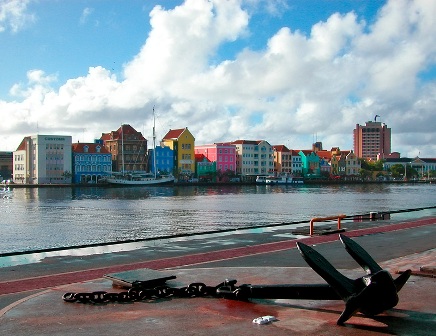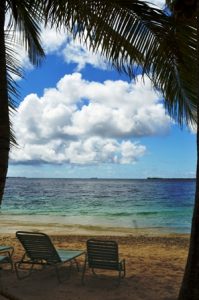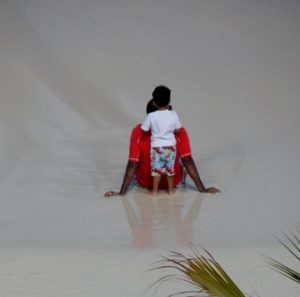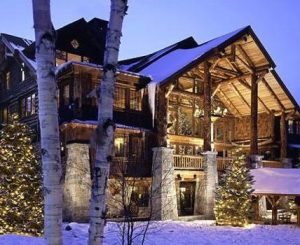by Barbara Barton Sloane
“Blanch your plantains!” our instructor commands in a no-foolin’-around voice. Blanch? “What does blanch mean?” I furtively whisper to Julia, my partner in this off-the-wall adventure. You see, we were cooking for our supper in Angelica’s Kitchen where our group of intrepid travelers has come for a lesson in traditional cuisine. Having already had a rather lengthy lesson in the art of knife-handling, and inhaling the ambrosial aromas wafting forth from boiling cauldrons, we looked forward to an evening that would end in a memory-making meal or – at the very least- an edible one.
A group of us, journalists all, are visiting Curacao, an island rich in history. Settled by natives of South America, in 1499 the Spanish arrived and, in 1634, the Dutch defeated them to stake their claim to the island. It is the largest and most populous of the three ABC islands of the Lesser Antilles: Aruba, Bonaire and Curacao. It is under 3 hours flight time from Miami and a mere 35 miles north of Venezuela.
Bon Bini!
 What makes Curacao unique and special among the Caribbean islands? Naturally there’s the transparent turquoise sea, the soft white sand, the ubiquitous palm trees swaying in the breeze. So, the difference? In a word: Authenticity. And, accomplishing the seeming impossible, Curacao still feels undiscovered, almost like an exclusive hideaway that only you were smart enough to find. It has a heritage both European and African. Spanish, Dutch, British, African and Jewish settlers have each added their own distinct flavor and today more than 50 nationalities are represented here. On my visit I heard a profusion of languages and islanders frequently greeted us with a lusty Bon Bin! which means welcome in Papiamentu, the local language.
What makes Curacao unique and special among the Caribbean islands? Naturally there’s the transparent turquoise sea, the soft white sand, the ubiquitous palm trees swaying in the breeze. So, the difference? In a word: Authenticity. And, accomplishing the seeming impossible, Curacao still feels undiscovered, almost like an exclusive hideaway that only you were smart enough to find. It has a heritage both European and African. Spanish, Dutch, British, African and Jewish settlers have each added their own distinct flavor and today more than 50 nationalities are represented here. On my visit I heard a profusion of languages and islanders frequently greeted us with a lusty Bon Bin! which means welcome in Papiamentu, the local language.
We took a tour of Willemstad, Curacao’s capital city and a UNESCO World Heritage site. Row upon row of candy-colored houses – pink, green, yellow, turquoise – gave the town a pretty, fairytale look. The homes featured pitched gables, shady verandas, jalousie windows and many were covered with cascading bougainvillea, a flowering plant that’s considered good luck. In fact, on New Year’s Eve, people use the flowers to make a fragrant water to wash down their houses, thus insuring a fortuitous new year.
Orange is the new….well, Orange
At least on this day. The people of Curacao wear many bright colors but on April 30 of each year, it’s orange or nothing. The bright hue is the national color of The Netherlands and this date marks the Queen’s birthday, so Celebration Time is On! The atmosphere was festive as we danced in the street to the rhythms of calypso, meringue, tango, reggae and salsa. Although I found myself with not a stitch of orange clothing, I joined the thousands of revelers and made do with a bright, exotic orange flower stuck behind my ear. It worked.
Taking the Plunge
 After the swinging, hectic celebration of Queen’s Day, I awoke to the sound of the ocean softly beckoning outside my window. It was a call I had to answer, opting for a day of lazing on sparkling white sand of the iconic Avila Hotel and trying out my new snorkel gear. The water was warm as a bath and of a blue so luminous it defied description, making the view below a colorful romp with the myriad fishes that swim near the shore. Snorkeling is right up my particular alley – not scary, yet allowing me to feel I’m doing something really adventurous. However, for those of you who want to delve deeper, you should know that Curacao is a scuba diving paradise, among the best in the world with 165 dive locations, and a chance to view endangered coral reefs and ancient ship wrecks. That evening, we dined at Belle Terrace, Avila’s seaside restaurant, serenaded by a trio playing traditional island songs and sitting under a huge silver globe. Can that really be the moon? Yes, it was.
After the swinging, hectic celebration of Queen’s Day, I awoke to the sound of the ocean softly beckoning outside my window. It was a call I had to answer, opting for a day of lazing on sparkling white sand of the iconic Avila Hotel and trying out my new snorkel gear. The water was warm as a bath and of a blue so luminous it defied description, making the view below a colorful romp with the myriad fishes that swim near the shore. Snorkeling is right up my particular alley – not scary, yet allowing me to feel I’m doing something really adventurous. However, for those of you who want to delve deeper, you should know that Curacao is a scuba diving paradise, among the best in the world with 165 dive locations, and a chance to view endangered coral reefs and ancient ship wrecks. That evening, we dined at Belle Terrace, Avila’s seaside restaurant, serenaded by a trio playing traditional island songs and sitting under a huge silver globe. Can that really be the moon? Yes, it was.
During colonial times, a good part of the merchant class that moved to Curacao was comprised of Sephardic Jews looking for religious freedom. Our tour included a visit to The Jewish Cultural Museum which housed a fascinating display of objects illustrating the customs and traditions of these early settlers and the history of a community going back hundreds of years. The museum is a part of the oldest synagogue in continuous use in the Western Hemisphere – Mikve Israel Emanuel – a wondrous building to behold.
 Our stay at the Kura Hulanda Hotel was special. Our rooms were furnished with hand-carved mahogany and teak furniture and was surrounded by attractive bluestone walkways, boutiques, restaurants and sculpture gardens, all done in 18 th and 19 th century Dutch colonial style.
Our stay at the Kura Hulanda Hotel was special. Our rooms were furnished with hand-carved mahogany and teak furniture and was surrounded by attractive bluestone walkways, boutiques, restaurants and sculpture gardens, all done in 18 th and 19 th century Dutch colonial style.
There are two spectacular pools, including a grotto surrounded by natural rock formations and fed by a calming waterfall. On its site is the Kura Hulanda Museum, a beautifully-curated, anthropological gem that focuses on the predominant cultures of Curacao, exhibiting the trans-Atlantic slave trade in its totality. There is a vast collection of artifacts from Continental Africa, the largest of its kind in the Caribbean. We found one of the more remarkable pieces in the museum’s garden – a standing woman sculpture, one side of her face beautiful and beguiling, and the other side displaying the continent of Africa.
Fun for the Whole Family
If you’d like to venture into a cavern, take a tour of Hoto Caves. They are open daily except Monday. Guided tours will take the family through the stalactite and stalagmite-filled rooms, several of which include pools and waterfalls.
A definite winner with the kids, the Sea Aquarium is one of the Caribbean’s finest marine exhibits. There are local fish, coral and sponges but it is the outdoor tanks with sharks, sea turtles and stingrays that really captivate. Want to swim with the fishes? At the Curacao Dolphin Academy, you can swim, snorkel and even dive with these special creatures.
Pull your head up out of that sugary white sand and take the family to the Curacao Ostrich Farm with a population of over 600 birds, one of the biggest farms outside of Africa. Kids (of all ages) are fascinated to view how ostriches live and breed.
As our Curacao travels came to an end, I’m happy to report that at Angelica’s Kitchen I did learn to blanch and, in fact, all of my cooking buddies did a great job with their assigned dishes. Cooking together, messing up, laughing a lot, making new friends, and ultimately turning out a darn good meal is an experience I’d highly recommend. Leaving Angelica’s we felt sated, convivial, and very Bon-Bini-ed – a memorable Curacao experience!
SIDEBAR
Hotels:
Avila Hotel (from $140/night)
www.avilahotel.com
Hotel Kura Hulanda (from $135/night)
www.kurahulanda.com
Restaurants:
Moon Restaurant (dinners $15-$45)
www.mooncuracao.com
Jaanchie’s (dinners $14-20)
To Do:
Angelica’s Kitchen ($105 per person)
www.angelicas-kitchen.com
Jewish Historical Cultural Museum
www.snoa.com
GETTING THERE:
American Airlines has 5 daily flights to Curacao via Miami from as low as $154.00
Photos courtesy of Sloane Travel Photography
- Willemstad
- The Sea at Curacao
- Sculpture from the Kura Hulanda Museum
 Biking, busing, tramming or hoofing it, Amsterdam is a city easy to get around. It has beauty, charm, and hundreds of canals connected by 500 pretty bridges – and flowers everywhere! These 17th century canals enjoy the honor of having been added to the UNESCO World Heritage List in 2010 and their grassy banks are perfect paths for a romantic stroll.
Biking, busing, tramming or hoofing it, Amsterdam is a city easy to get around. It has beauty, charm, and hundreds of canals connected by 500 pretty bridges – and flowers everywhere! These 17th century canals enjoy the honor of having been added to the UNESCO World Heritage List in 2010 and their grassy banks are perfect paths for a romantic stroll.
 The ceremony of christening and launching a ship is based on traditions thousands of years old – to protect the ship and all who sail her. A Babylonian narrative dating from the 3 rd millennium BC describes the completion of a ship:
The ceremony of christening and launching a ship is based on traditions thousands of years old – to protect the ship and all who sail her. A Babylonian narrative dating from the 3 rd millennium BC describes the completion of a ship: A world of wonder is what you find at Turkey’s Black Sea. The region is rich in heritage, in sights, in culture – from stunning landscapes and natural wonders to World Heritage sites – here in all its ancient and mesmerizing glory. Standing on top of Al-Petri Mountain, one may wonder why such an iridescent blue sea is called the black sea. It’s thought that the name was given to it by sailors and pirates who were struck by its dark appearance when the sky turned leaden with storm clouds. Known by another name as well, the ancient Greeks called it the Scythian Sea as they plundered shipwrecks and made wine goblets from sailors’ skulls. Happily, on a recent visit I enjoyed my wine served in a pretty crystal glass as I gazed out over a perfect Blue sea. Reasons to make this your next go-to vacation spot are many. Here are just a few of them:
A world of wonder is what you find at Turkey’s Black Sea. The region is rich in heritage, in sights, in culture – from stunning landscapes and natural wonders to World Heritage sites – here in all its ancient and mesmerizing glory. Standing on top of Al-Petri Mountain, one may wonder why such an iridescent blue sea is called the black sea. It’s thought that the name was given to it by sailors and pirates who were struck by its dark appearance when the sky turned leaden with storm clouds. Known by another name as well, the ancient Greeks called it the Scythian Sea as they plundered shipwrecks and made wine goblets from sailors’ skulls. Happily, on a recent visit I enjoyed my wine served in a pretty crystal glass as I gazed out over a perfect Blue sea. Reasons to make this your next go-to vacation spot are many. Here are just a few of them:
 I was awake yet was, most definitely, in a dream – the “SeaDream” Yacht to be precise. Cruising along the Amalfi Coast of Italy, heading toward ports I’d only fantasized about, it was a pinch-myself moment. Yes, this was true life. Let the dreaming begin!
I was awake yet was, most definitely, in a dream – the “SeaDream” Yacht to be precise. Cruising along the Amalfi Coast of Italy, heading toward ports I’d only fantasized about, it was a pinch-myself moment. Yes, this was true life. Let the dreaming begin!
 photo opps. From Amalfi’s harbor, a car took us up narrow, twisting and winding, white-knuckle roads to Ravello, one of the most famous spots on the Amalfi Coast and home in the past to Greta Garbo, Gore Vidal and D.H. Lawrence. Romantic Sorrento offered a high-point lookout where we could spy the ruins of Pompeii. Finally, one day we heard a crew member shout: “Here comes Capri!” Now I ask you, can there ever be a happier, more thrill-producing call?
photo opps. From Amalfi’s harbor, a car took us up narrow, twisting and winding, white-knuckle roads to Ravello, one of the most famous spots on the Amalfi Coast and home in the past to Greta Garbo, Gore Vidal and D.H. Lawrence. Romantic Sorrento offered a high-point lookout where we could spy the ruins of Pompeii. Finally, one day we heard a crew member shout: “Here comes Capri!” Now I ask you, can there ever be a happier, more thrill-producing call?
















